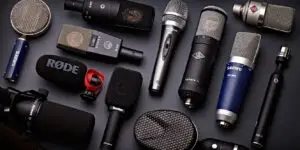How to Choose the Right Microphone for Your Voice:
Essential Tips for Optimal Sound Quality
Choosing the right microphone for your voice can make a big difference in how you sound in recordings or performances. The key to finding the best microphone lies in understanding your voice type and matching it with the right microphone characteristics. Whether recording music or voiceovers, the right mic can enhance clarity and warmth.

Different microphones serve different purposes, and knowing the types can help narrow down choices. Factors like environment, vocal style, and specific sound preferences all play a role in this decision. Each microphone has unique features that cater to various needs, so it’s important to think about what will work best for your voice.
With a little research and consideration, anyone can find a microphone that suits them perfectly. The right choice can elevate sound quality and make a significant impact on any project.
Key Takeaways
- Understanding voice types helps in selecting the correct microphone.
- Different microphone features cater to various recording needs.
- The right microphone can significantly enhance sound quality.
Understanding Microphone Types

Microphones come in various types, each designed for specific uses and environments. Knowing the differences can help in selecting the right microphone for individual voice types and applications. Here are three main types of microphones: dynamic, condenser, and ribbon.
Dynamic Microphones
Dynamic microphones are popular for live performances and loud sound sources. They use a diaphragm, voice coil, and magnet to convert sound into electrical signals. These microphones are durable and can handle high volume levels without distortion.
They are less sensitive than other types, making them suitable for environments with a lot of background noise. Commonly used for vocals and instruments, they excel in stage settings. Brands like Shure and Sennheiser offer reliable dynamic models.
Key features include:
- Durability: Strong build that withstands rough handling.
- Versatility: Works well with various sound sources.
Condenser Microphones
Condenser microphones are known for their sensitivity and accuracy. They require an external power source, often referred to as phantom power, to operate. This type is ideal for studio recording because they capture detail and nuance in vocals and instruments.
Condenser mics have a wider frequency response and are better suited for quieter environments. They can pick up subtle sounds, making them a favourite for vocals, acoustic instruments, and podcasts. Brands such as Audio-Technica and Rode produce high-quality condenser microphones.
Key features include:
- Sensitivity: Captures soft sounds and details.
- Frequency Response: Handles a wide range of frequencies.
Ribbon Microphones
Ribbon microphones offer a unique sound character. They use a thin metal ribbon suspended in a magnetic field to create sound. This type of microphone is known for its warm and natural tone.
Though they can be more fragile than dynamic and condenser microphones, ribbon mics are prized in studio settings for their smooth sound quality, particularly with vocals and brass instruments. Brands like Royer and AEA are well-respected in this category.
Key features include:
- Natural Sound: Produces a smooth and warm tone.
- Fragility: Requires careful handling to avoid damage.
Factors Affecting Microphone Choice

Choosing the right microphone involves several important factors. Each factor influences how a microphone captures sound and works with different voice types. Key points include pickup patterns, frequency response, and impedance and sensitivity.
Pickup Patterns
Pickup patterns determine how a microphone picks up sound from different directions. The most common patterns are:
- Cardioid: Picks up sound in front. Good for vocals, reducing background noise.
- Omnidirectional: Captures sound from all around. Useful for group settings or ambient sounds.
- Bidirectional: Picks up sound from the front and back. Great for interviews.
Understanding the pickup pattern helps users choose a microphone suitable for their environment and voice type.
Frequency Response
Frequency response describes how well a microphone captures different sound frequencies. It is measured in hertz (Hz) and typically looks like this:
- Low Frequencies (20-200 Hz): Important for bass and depth.
- Mid Frequencies (200 Hz – 2 kHz): Crucial for most vocal tones.
- High Frequencies (2 kHz – 20 kHz): Adds clarity and detail.
A microphone with a flat frequency response provides a balanced sound. However, some microphones boost certain frequencies to enhance particular vocal qualities.
Impedance and Sensitivity
Impedance affects how well a microphone works with mixers or audio interfaces. Low impedance microphones (below 600 ohms) are common for modern setups. They help maintain sound quality over longer distances.
Sensitivity measures how effectively a microphone captures sound. Higher sensitivity means the microphone requires less sound pressure to produce a strong signal. A microphone with high sensitivity is ideal for quieter voices or soft sounds.
Choosing a microphone with the right impedance and sensitivity is essential for optimal sound quality.
Frequently Asked Questions

Choosing the right microphone requires attention to specific factors that can greatly affect how a voice sounds in recordings. The needs for different vocal types and recording environments also play a key role in making the best choice.
What factors should be considered when choosing a microphone for vocal recording?
When selecting a microphone for vocal recording, key factors include the microphone type, polar pattern, frequency response, and sensitivity. Dynamic microphones are durable, while condenser microphones typically capture more detail. The polar pattern determines how sound is picked up, affecting clarity and background noise.
Which microphone characteristics are important for female vocalists?
For female vocalists, a microphone with a smooth frequency response in the 3kHz to 6kHz range is important, as it emphasises clarity in the higher registers. A condenser microphone is often a good choice due to its sensitivity. The microphone’s polar pattern should also suit the recording environment to reduce unwanted sounds.
Can you recommend a suitable microphone for recording male vocals?
A popular choice for recording male vocals is the Shure SM7B. This dynamic microphone is known for its versatile sound and ability to handle various vocal styles. Another solid option is the Audio-Technica AT2020, a condenser mic that delivers clear sound across a range of frequencies.
What are the best microphones for recording vocals at home?
For home recording, USB microphones like the Blue Yeti or Audio-Technica AT2020 USB are great due to their ease of use and sound quality. For those seeking higher quality, an XLR microphone, like the Rode NT1-A, paired with an audio interface can provide excellent results.
How does microphone selection vary for live versus studio singing?
In live settings, dynamic microphones, such as the Shure SM58, are often preferred for their durability and feedback rejection. In contrast, studio recordings benefit from condenser microphones, which capture greater detail and subtlety, making them ideal for layered vocals and intricate performances.
What should you look for in a microphone to improve vocal sound quality?
To improve vocal sound quality, look for a microphone that has a wide frequency response and low self-noise. Consider the polar pattern, ensuring it suits the recording space. A good pop filter can also help reduce plosive sounds, enhancing the overall clarity of the vocal recordings.







